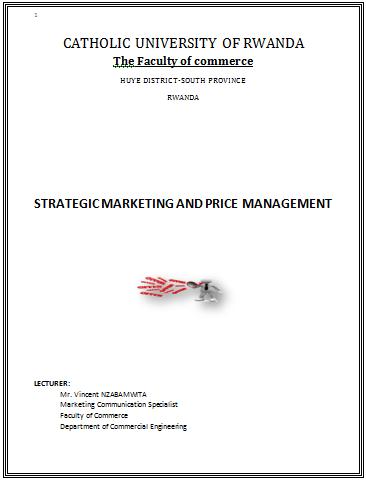MODULE NAME: STRATEGIC MARKETING AND PRICE MANAGEMENT
LEVEL: 5 Semester: II
|
Module code |
Module No. |
Course name |
Subject units |
Credits |
|
MAIS5213 |
|
STRATEGIC MARKETING AND PRICE MANAGEMENT |
Pricing strategies |
10 |
|
Consumer and competitor analysis |
10 |
|
Year (the module is thought in which year?) |
Theoretical (Hours) |
Practical (Hours) |
Total hours |
Credits |
|
Level four |
80 |
120 |
200 |
20 |
Allocation of Study Hours
|
Module Outline |
Student hours |
Lecturer Hours |
|
Face to face Lectures |
60 |
60 |
|
Seminar/workshops |
- |
- |
|
Practical classes/laboratory |
- |
- |
|
Structured exercises |
30 |
10 |
|
Set reading |
20 |
- |
|
Self-directed study |
50 |
- |
|
Assignments-preparation and writing |
40 |
10 |
|
TOTAL |
200 |
80 |
Brief description of aims and content
The aim of this strategic marketing and price management module is to enable students to analyse the pricing strategies and consumer and competitors. A business can use a variety of pricing strategies when selling a product or service. The price can be set to maximize profitability for each unit sold or from the market overall. It can be used to defend an existing market from new entrants, to increase market share within a market or to enter a new market.
Pricing is one of the most vital and highly demanded components within the theory of marketing mix. It helps consumers to have an image of the standards the firm has to offer through their products, creating firms to have an exceptional reputation in the market.
Whereas the competition within the market today is extremely high, for this reason, businesses must be attentive to their opponent’s actions in order to have the comparative advantage in the market. The American Marketing Association defines market research as: "The systematic gathering, recording, and analysis of data about problems relating to the marketing of goods and services". Consumer analysis is an important part of this marketing research. Without marketing research, it is quite impossible today to start any business. Consumer analysis is the first step of any marketing research.
In this module, the objectives are to develop the skills in pricing strategies and consumer analysis.
Learning Outcomes
Knowledge
Having successfully completed the module, students should be able:
ü To know the Roles, Approaches, Policies and objectives of pricing strategies
ü To know the influencing factors and Product life cycle
ü To know the national and international Pricing strategies
ü To know the consumer analysis and customer profitability
ü To know the business idea, competitor analysis and competitive strategies
Skills
After completing the module, successful students should be able:
ü To define the Roles, Approaches, Policies and objectives of pricing strategies
ü To differentiate the influencing factors and Product life cycle
ü To differentiate the national pricing strategies and international Pricing strategies
ü To deliver the business idea, competitor analysis and competitive strategies
Attitude
Having successfully completed the module, students should be able to demonstrate attitude of:
ü Illustrating the Roles, Approaches, Policies and objectives of pricing strategies
ü Understanding the influencing factors and Product life cycle
ü Analyzing the various the national pricing strategies and international Pricing strategies
ü Defining the business idea, competitor analysis and competitive strategies
Learning and Teaching strategy
Activities and methods used to move the learner towards achievement of the learning outcome. Basic knowledge and understanding are developed in lectures which contain explanations of techniques and strategies.
There will be exercises and assignment to enable the students to reflect on and deepen what they are learning. Some works will be done individually, others in groups Lecture notes are provided at the beginning of the module delivery.
Assessment Strategy
The teaching methods will align with the outcome and with the outcome evaluation. There will be a lot of assessment during the module delivery some of which will be recorded and constitute 60% of the final mark. At the end of the module there will be a final written examination which will count 40%.
Assessment Pattern
|
Component |
Weighting (%) |
Learning outcomes covered |
|
Continuous Assessment and Test (CAT) |
60% |
Refer to Learning outcomes |
|
Final Exams |
40% |
Refer to Learning outcomes |
Strategies for feedback and student support during the module
Ø Continuous assessment techniques
Ø Assignments with immediate feedback
Ø Lecturer’s availability for consultations for which office hours will be announced in advance and respected

- Teacher: Mr. Vincent NZABAMWITA
